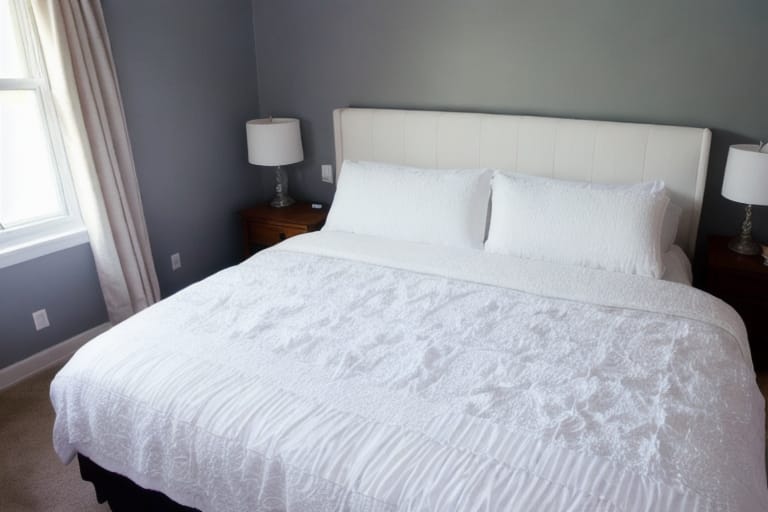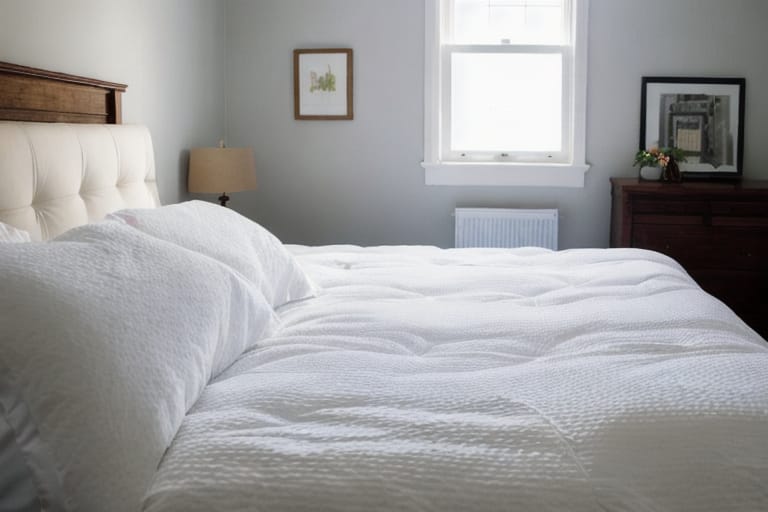When it comes to bedding, down comforters stand out as a top choice for their superior warmth, fluffiness, and durability compared to other fills. But with so many options on the market, how can you evaluate whether a comforter contains high-quality down versus cheaper feather mixes or down alternatives?
By understanding key indicators like fill power, thread count, construction, and certification standards, you can recognize authentic, premium down comforters to enjoy steady nights of blissful sleep. This guide breaks down everything you need to know about what sets real goose down apart.
An Overview of Bedding Types
Before diving into down specifically, let’s quickly define the main bedding categories to set the stage:
- Sheets: Thin, fitted fabrics placed directly on the mattress
- Bedspreads: Decorative top layers meant for design rather than warmth
- Comforters: Thick, fluffy blankets to provide insulation and comfort
- Duvets: Inserts filled with either down or down alternative materials
- Coverlets: Lightweight, decorative blankets placed over the top bed layer
- Blankets: Heavyweight blankets used as top layers or alone in warm weather
- Quilts: Sandwich layers stuffed with filling and stitched through for texture
- Pillowcases: Removable covers that protect pillows
Comforters and duvets with down filling rise to the top for long-lasting plushness and regulated body temperature control.
Determining Down Fill Power
The most important marker of down quality is fill power, which measures the loft and insulation capacity using cubic inches per ounce. Loft refers to the fluffiness, volume, and thickness of the down:
The higher the fill power, the better the thermoregulation. Here’s how it breaks down:
- Under 500 – Low quality down and warmth
- 500-599 – Decent mid-weight comforter
- 600-699 – Good quality with nice loft
- 700-799 – High-end with excellent insulation
- 800 and above – Maximum loft and warmth
Ideally, look for a fill power over 600 fp for optimal night’s sleep.
Evaluating Thread Count
Down fill power provides warmth while the outer shell keeps the down secure. This shell consists of fabrics like cotton sateen or cotton cambric along with the all-important thread count, which indicates quality:
The thread count signifies the number of threads woven together per square inch in the shell fabrics. For down comforters:
- Under 200 – Low budget quality
- 200-400 – Decent mid-tier density
- 400-600 – Good quality shell fabric
- Over 600 – Luxurious fine fabrics
Ideally, look for 400 thread count and higher for sufficient protection, longevity, and cozy feel.

Construction: Boxes, Sewing, and Piping
Down demands sturdy construction shaped by precise sewing and reinforced edges to prevent shifting. Key aspects to evaluate include:
Baffle Boxes
Interior baffle boxes created by the sewing pattern keep the fill evenly distributed:
High-quality down comforters have smaller boxes to minimize shifting.
Stitching
Reinforced double or triple stitching along the seams ensures durability. No loose threads or uneven corners.
Piping
Edge piping adds structure and flair along the sides.
Thick piping maintains shape and provides an aesthetic upgrade.
Seeking Third-Party Certifications
Independent testing helps verify the authenticity and ethics behind Goose Down:
- RDS Certification – Ensures humane harvesting and sourcing
- Downpass Certification – Verifies sterilization for purity and cleanliness
- OEKO TEX Certification – Confirms no harmful substances
- IDFB Certification – Validates accurate fill power through analysis
Certifications provide credibility and confidence in purchasing high-fill power down.
Top 5 Highest Value Down Comforters
Now that we understand how to assess for quality down, here are my top comforter recommendations offering excellent warmth, loft, and construction:
1. Brooklinen Down Comforter
- 700 fill power white down
- 400 thread count cotton shell
- Baffle boxes to limit shifting
- 550 USD for Queen
2. Buffy Cloud Down Comforter
- 750 fill power white down
- 300 thread count shell
- Ships vacuum-compressed
- 160 USD for the Queen
3. Parachute Down Duvet Insert
- European white down
- 500 thread count cotton cambric
- Corner loops to secure duvet
- 349 USD for the Queen
4. Boll & Branch Down Comforter
- 700 fill power down
- 330 thread count organic cotton
- Gusseted edges prevent shifting
- 450 USD for Queen
5. Downlite Extraordinaire 700 fp Down Comforter
- 700 fill power goose down
- 230 thread count cotton shell
- Double-stitch reinforced edges
- 479 USD for the Queen
Using the criteria covered throughout this guide–fill power, thread count, certifications, and overall construction–these comforters offer exceptional quality and value sure to please.
Caring for a High-End Down Comforter
To extend the lifespan of a premium down comforter:
- Dry clean for thorough, safe cleaning
- Use mild dryer cycles on low when needed
- Natural light helps refresh periodically
- Air out the comforter before storage
- Store in a breathable bag in the closet
By caring gently for down bedding, you can enjoy lasting comfort and warmth for over a decade.
Down vs. Alternative: Which is Better For You?
While quality down reigns supreme in many performance factors like warmth, loft, and durability, down alternative comforters offer decent replicas for a fraction of the cost.
For those with tight budgets or animal product avoidance, alternative down merits consideration with its mid-level insulation and significantly lower price point. Made from synthetic fibers like rayon and polyester blended with cotton or microfiber, these hypoallergenic comforters mimic certain properties of natural down.
However, alternatives frequently shift, lose shape faster, and run a higher risk of odor or dust mites over time. So while short-term, occasional, or guest room use serves fine, hardcore cold sleepers and those wanting lasting longevity are better off investing in the enduring comfort of genuine down bedding.

Achieving Your Best Sleep with Down
Few bedding upgrades impart lasting luxury and rest quite like slipping under a premium down-filled comforter or duvet. When combined with breathable sheets, supportive pillows, and a stable mattress, enjoy drifting into blissful slumber wrapped in gentle warmth as the down conforms perfectly to your body all night long.
By using this guide to recognize true, high-quality down comforters, you now hold the keys for evaluating fills, fabrics, and construction needed to identify authentic options that promote rejuvenating sleep for years on end. Rest easy knowing exactly what to seek for your fuzziest dreams ahead.
Frequently Asked Questions
What thread count is best for a down comforter?
For down comforters, a thread count between 400-600 is ideal for both durability and a soft, cozy feel. Under 200 thread count is lower quality while over 600 ventures into premium luxury territory.
What size down comforter do I need?
Choose a comforter based on your mattress size – Twin, Twin XL, Full, Queen, King, or California King. For ultimate coverage, consider oversized comforters approximately 2 inches longer and wider than your actual mattress. Custom sizing is also available.
How do I know a down comforter will keep me warm enough?
Pay attention to the fill power, which measures the loft and warmth capacity. Aim for 700+ fill power for outstanding insulation. Combine with higher thread count shells to contain heat. Also note comforter weight, usually given in ounces – higher ounces contain more down fill.
Are down comforters good for all seasons?
Yes! Unlike heavy quilts which can overheat in summer, adjustable duvet covers allow modifying layers as needed. Some comforters even have corner loops to attach covers. Switch from cozy flannel in winter to crisp, breathable cotton covers for year-round comfort.
Should I get a 100% down or down alternative comforter?
Choose 100% white goose or duck down for unparalleled softness, contouring support and temperature regulation. Make sure the manufacturer explicitly states “100% down” as many use lower-cost feather mixes. Down alternative comforters with synthetic fills work well for budget buys although frequently lose shape faster than real down.








